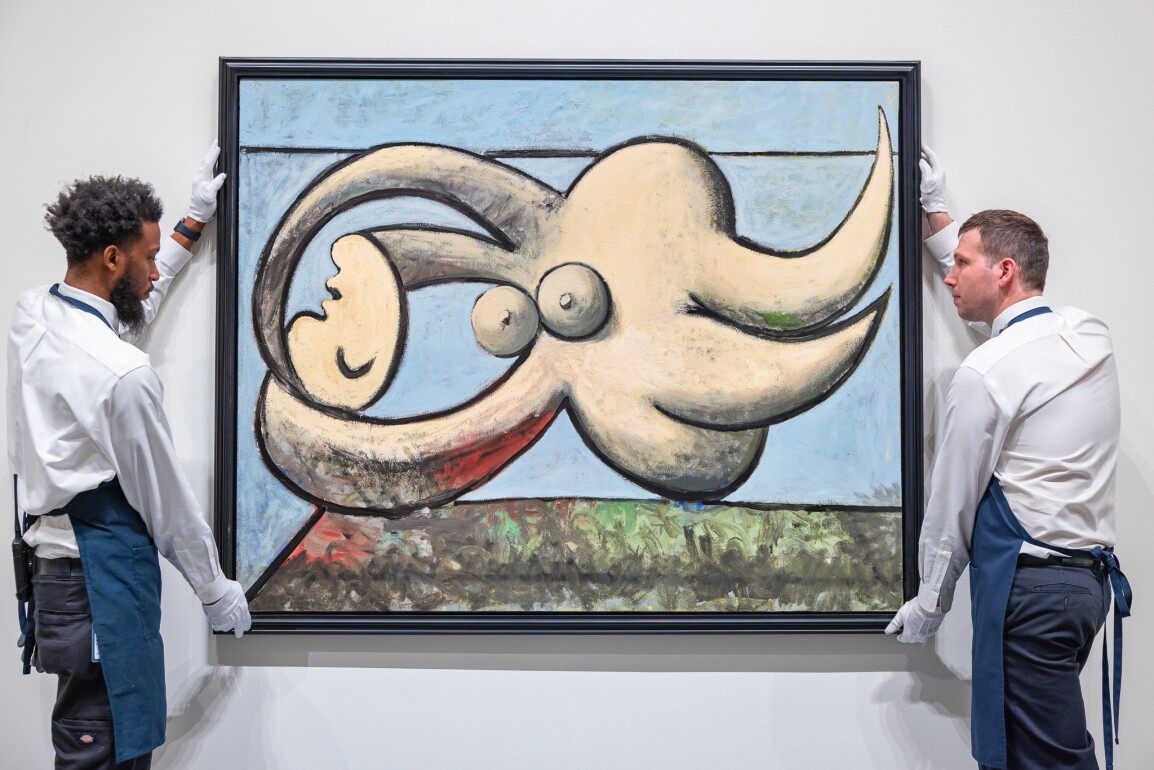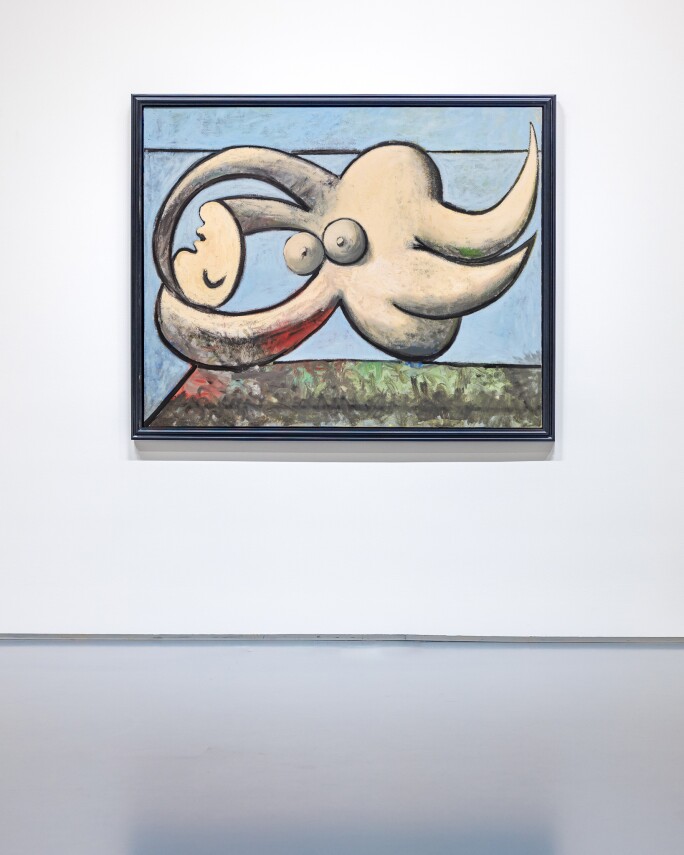P ainted in April 1932, 90 years ago to the month, Femme nue couchée is one of Pablo Picasso’s most monumental and uninhibitedly sensual portrayals of Marie-Thérèse Walter. Appearing at auction for the first time, the large-scale painting is poised to achieve in excess of $60 million at Sotheby’s Modern Evening Auction on 17 May, making it one of the most valuable portraits of Marie-Thérèse Walter ever offered at auction.
Marie-Thérèse was the inspiration for many of Picasso’s greatest works, with 1932 - the year in which he was finally able to give full painterly voice to his passion - widely regarded as his ‘annus mirabilis’. So extraordinarily was Picasso’s output that year, an entire museum exhibition has been dedicated to it (“Paris 1932”, at Tate Modern in 2018). And while the works from this moment stand out for their creativity and their joyous mood, what perhaps marks them out most of all is the intensity of desire that underpins them. (In fact, the French leg of exhibition at the Musee Picasso was called “Paris 1932: année erotique”.)
Femme nue couchée a Monumental Achievement in Picasso’s Oeuvre and the History of Portraiture, Is Poised to Achieve in Excess of $60 Million

But of the many portraits Picasso painted of Marie-Therese in that year, this particular image stands out: it is a uniquely compelling composition that is radically different, both from anything else in his oeuvre, and from the broader art historical tradition of the female reclining nude. In this work, Picasso evokes Marie-Therese with the strong and sensuous fin-like limbs of a sea-creature. Though he would go on to render subsequent lovers in animalistic form, the allusion to the sea here is significant: Marie-Thérèse was also an avid and accomplished swimmer whose powerful, athletic grace in the water was a source of constant fascination for Picasso (something that was perhaps all the more beguiling for him, given that – for all the time he spent on the beach as a child and subsequently – he in fact he never learned to swim). In addition to which, the headiest days of their blossoming relationship were spent by the sea: in the summer of 1928, Picasso took his then-wife Olga and son Paulo to the seaside at Dinard. Unbeknown to them, he also installed his then-still-secret-lover Marie-Thérèse in a holiday camp nearby, ‘eloping’, whenever possible for secret romantic encounters by the sea.
“Picasso’s portraits of his golden muse Marie-Thérèse are undeniable hallmarks of 20th century art. When unveiled at his career retrospective in 1932, this cycle of monumental works scintillated with their rapturously romantic and sensuous depiction of Picasso’s heretofore sequestered mistress. A radical departure from tradition, this striking painting is at the same time a deeply lyrical ode to the artist’s unbound desire for Marie-Thérèse; with her fin-like, endlessly pliable limbs, the portrait continues to enchant as it perfectly captures Picasso’s muse as the ultimate expression of his genius.”

Furthermore, a lover of the sea (‘I am a child of the sea; I long to bathe in it, to gulp down the salty water’) and an avid film goer, Picasso may well have been influenced in this composition by Jean Painlevé’s 1928 surrealist masterpiece, La Pieuvre, “a captivating love letter to one of nature's most intelligent and enigmatic creations.”
Building on the lineage of the reclining nude in art history, Picasso’s Femme nue couchée offers a daring new take on the tradition, upending naturalism for the biomorphic forms of Surrealism and a curvilinear approach derived from his simultaneous sculptural practice, which would prove highly influential to generations of artists to come.
In early 1932 Picasso was planning a major retrospective scheduled for June, and in preparation for the exhibition began his first dedicated series of paintings depicting his muse and mistress Marie-Thérèse Walter in the seclusion of his new country home of Boisgeloup. In Femme nue couchée, which was completed during this period, Picasso charted new territory with his portrait of Marie-Thérèse, not only in his own body of work, but in the history of the nude figure with his depiction of her reclining in a highly abstracted space, highlighting her biomorphic figure with touches of fertility, sexuality, and grace. As a landmark work within Picasso’s oeuvre and his famed series completed in 1932, as well as a pivotal exampale in the history of portraiture, Femme nue couchée’s arrival at auction for the first time this Spring marks a significant moment in Picasso’s unrivaled legacy in the art market.
“As one of the star highlights of Tate Modern’s world-class exhibition devoted to 1932 as a pivotal year for Picasso, Femme nue couchée is a ground-breaking, extraordinarily sensual work that remained within the artist’s estate for decades before its acquisition directly from the family of the artist . Marking the first time this painting will appear at auction, our Modern Evening Sale will be a defining moment in solidifying 1932 as one of Picasso’s most critically important and sought-after periods.”

The story of Picasso’s first encounter with Marie-Thérèse, and their subsequent love affair, is among the most compelling in 20th century art history. Picasso first met Marie-Thérèse in Paris in 1927 when she was seventeen years old. The couple’s relationship was kept a well-guarded secret for many years, both on account of the fact that Picasso was then still married to Olga Khokhlova, a Russian-Ukrainian dancer he had met on tour with Diaghilev, and because of Marie-Thérèse’s age. It was during these preceding months that he first cast his artistic spotlight on the voluptuous blonde. Until then, Picasso had only referenced his extramarital affair with Marie-Thérèse in code, sometimes embedding her symbolically in a composition or rendering her unmistakable profile as a feature of the background. But by the end of 1931, Picasso could no longer repress the creative impulse that his lover inspired, and over Christmas 1931 and into early 1932, Marie- Thérèse emerged, for the first time, in fully recognizable, languorous, form in his work.
For Picasso, Marie-Thérèse offered a sensual amalgam of the lover, the model, and the goddess, and would be cast in many roles throughout his body of work. In Boisgeloup, Picasso increasingly devoted his time and creative energy to sculpture, including a number of plaster busts and reclining nude portraits of Marie-Thérèse. The influence of this medium is visible in Femme nue couchée in the monumental sculptural force with which Picasso portrays the female body. At the same time, the psychological state of the sleeping woman resonates in the soft modelling of the figure, creating an atmosphere of reverie and carefree abandon. Seeking to convey his erotic desire, Picasso generates morphological permutations and distortions of the female anatomy. Abandoning any attempt at naturalism, he creates a figure composed of biomorphic forms, a technique that developed from his earlier, Surrealist works.
Picasso’s treatment of the female figure is undoubtedly rooted in the great tradition of the reclining nude in art history, following his predecessors Goya, Ingres, and Manet, among others. Yet, the artist’s shocking new take on the nude and frank sexuality would provide an influence to some of the greatest artists in the generations to follow.
“There were many notable years in the long, dramatic career of Pablo Picasso, but 1932 stands out as particularly momentous. In this ‘year of wonders,’ Picasso produced the most sensuous depictions of his great muse and lover Marie-Thérèse Walter, who would inspire some of the artist’s most iconic images. In Femme nue couchée, she is presented with a potent mix of sensuality and youthful naivety, and heralds a major creative turning point for Picasso as he was no longer willing to hide his passion and affair.”
Exhibition Schedule
Hong Kong 8 – 12 April
London 20 – 24 April
New York 6 – 17 May


